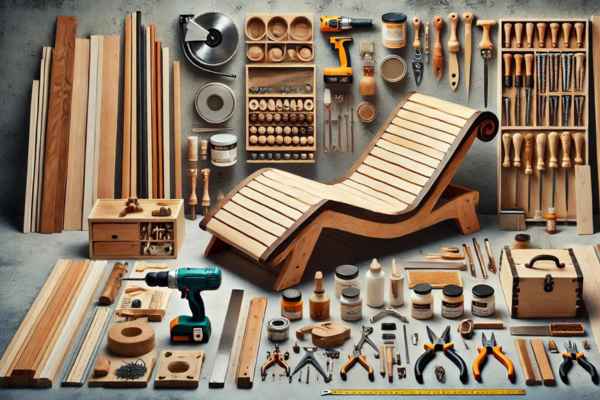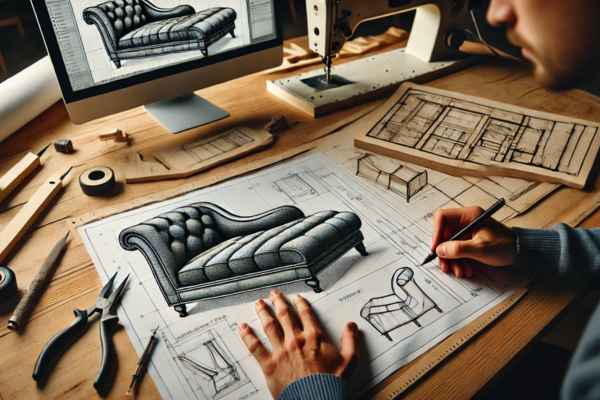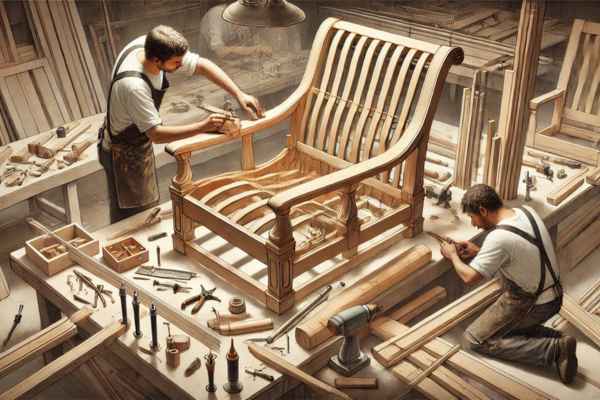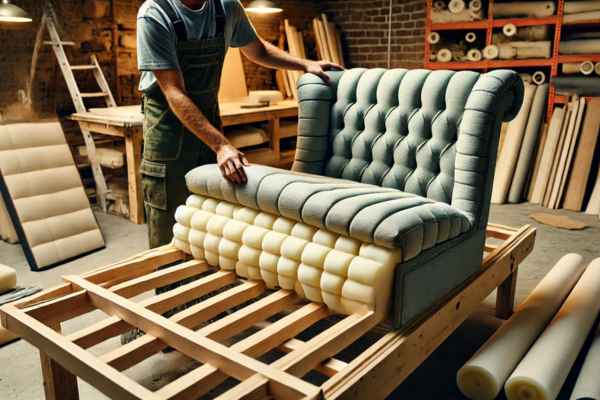Build Chaise Lounge can be a rewarding and fulfilling project for both novice and experienced woodworkers. A lounge is not only a stylish addition to any living space but also provides a comfortable spot for relaxation and leisure. Whether placed in a living room, bedroom, or outdoor patio, a well-crafted chaise couch can enhance the aesthetic appeal of your home while offering a perfect place to unwind. This guide will walk you through the essential steps to create a beautiful and functional chaise couch, from gathering the necessary materials to the final assembly.
Materials and Tools Needed

Before starting your chaise lounge project, it’s crucial to gather all the required materials and tools. You’ll need high-quality wood, such as pine, cedar, or teak, which are durable and suitable for furniture making. In addition, you’ll require screws, wood glue, sandpaper, and a finish or paint of your choice. Essential tools include a saw for cutting the wood, a drill for assembling the pieces, measuring tape for accuracy, clamps to hold pieces in place, and a sander for smoothing surfaces. Having all these materials and tools ready before you begin will streamline the construction process and ensure a successful outcome.
Planning and Design

The planning and design phase is a critical step in building a lounge. Start by determining the dimensions and style of the chaise couch that best suits your space and needs. Consider ergonomic factors to ensure maximum comfort, such as the height of the backrest, the angle of the seat, and the length of the lounge. Sketch a detailed plan or use design software to visualize the final product. This blueprint will serve as a guide during construction, helping you to cut and assemble the pieces accurately. Thoughtful planning will save time and reduce the likelihood of mistakes as you progress through the project.
Cutting the Wood

With a solid plan in place, the next step is cutting the wood according to your design specifications. Begin by marking the measurements on the wood using a pencil and measuring tape. Ensure precision to avoid any discrepancies that could affect the assembly. Use a saw to carefully cut the pieces, following the marked lines. It’s important to maintain a steady hand and follow safety precautions while using the saw. Once all the pieces are cut, use sandpaper or a sander to smooth the edges and surfaces, preparing them for assembly. Proper cutting and smoothing are essential for a professional-looking chaise couch that is both sturdy and aesthetically pleasing.
Building the Frame

The foundation of a sturdy chaise lounge lies in its frame. Begin by assembling the base frame using the precut wood pieces. Arrange the pieces on a flat surface according to your design plan and join them using screws and wood glue for added strength. It’s crucial to ensure that all corners are square and the frame is level to provide a stable foundation. Use clamps to hold the pieces together while the glue dries. This step is fundamental, as a solid frame guarantees the overall stability and longevity of your chaise couch.
Creating the Backrest

Once the frame is complete, focus on creating a comfortable and supportive backrest. The backrest should be designed to provide ample support for various reclining positions. Cut the wood pieces to the desired height and angle, then attach them to the frame using screws and wood glue. Reinforce the backrest with additional supports if necessary to ensure it can withstand regular use. Sand all the edges to smooth out any rough areas. A well-constructed backrest not only enhances the comfort of the lounge but also adds to its aesthetic appeal.
Adding the Seat

The seat of the chaise lounge is where comfort truly comes into play. Cut the seat panels to fit within the frame, ensuring they are flush with the edges. Attach the seat panels to the frame securely using screws. For added comfort, consider adding cushions or padding to the seat area. Upholster the seat with durable fabric that matches your décor and is easy to clean. This step transforms the chaise couch from a mere structure into a comfortable seating option, perfect for relaxation and lounging.
Installing the Legs
The final step in building your lounge is installing the legs. Choose legs that complement the design of the lounge and are sturdy enough to support its weight. Attach the legs to the underside of the frame using screws and wood glue, ensuring they are evenly spaced and securely fastened. It’s essential to check that the lounge sits evenly on all legs to prevent wobbling. Once the legs are installed, give the entire chaise couch a final sanding and apply a finish or paint to protect the wood and enhance its appearance. Your custom-built chaise couch is now ready for use, providing both comfort and style to your living space.
Sanding and Finishing
Once you have assembled the frame of your chaise couch, the next crucial step is sanding and finishing. Begin by using a medium-grit sandpaper to smooth out any rough edges or surfaces. This process not only enhances the aesthetic appeal but also ensures the longevity of the wood by preventing splinters and cracks. After the initial sanding, switch to a fine-grit sandpaper for a smoother finish. Dust off the wood thoroughly before applying a wood conditioner, which helps the stain absorb evenly. Choose a high-quality wood stain that matches your desired color and apply it evenly with a brush or cloth. Once the stain is dry, seal it with a clear polyurethane coat to protect against moisture and wear. This finishing step is vital for achieving a polished look and ensuring that your chaise couch withstands the elements, especially if it will be used outdoors.
Adding Cushions and Upholstery
Adding cushions and upholstery to your chaise lounge transforms it from a simple wooden structure into a comfortable and inviting piece of furniture. Start by measuring the chaise couch to determine the size and shape of the cushions you need. Choose a durable, weather-resistant fabric, especially if the lounge will be placed outdoors. You can purchase pre-made cushions or opt for custom-made ones to perfectly fit your lounge. If you’re upholstering the cushions yourself, ensure the fabric is tightly secured and neatly sewn to avoid any wrinkles or sagging. Attach the cushions to the frame using Velcro strips or ties to keep them in place. This addition not only enhances comfort but also adds a touch of style, making your lounge a standout piece in any setting.
Final Touches
The final touches are what set your chaise lounge apart and give it a personalized feel. Consider adding decorative elements like accent pillows, throws, or even a small side table for added convenience. You might also want to incorporate some functional features such as adjustable backrests or built-in storage compartments. Pay attention to the small details, like ensuring all screws and bolts are tightly fastened and that any exposed hardware is neatly covered. If your chaise couch will be used outdoors, consider adding protective pads to the feet to prevent damage to your deck or patio. These finishing touches not only enhance the functionality of your chaise lounge but also reflect your personal style and attention to detail.
Maintenance Tips
Proper maintenance is key to ensuring the longevity of your chaise lounge. Regularly check the structure for any signs of wear or damage, such as loose screws or cracked wood, and address these issues promptly. If your chaise couch is made of wood, reapply a protective sealant annually to keep it looking fresh and to protect it from the elements. For metal frames, check for rust and apply a rust-resistant primer and paint as needed. Upholstered cushions should be cleaned according to the fabric’s care instructions, and it’s a good idea to store them indoors during extreme weather conditions. By following these maintenance tips, you can keep your lounge looking and functioning like new for years to come.
What Type of Wood is Best for a Chaise Lounge?
Choosing the right type of wood is crucial for building a durable and aesthetically pleasing lounge. Hardwood varieties such as teak, cedar, and redwood are highly recommended due to their natural resistance to rot, decay, and insect infestations. Teak is particularly favored for its strength and weather-resistant properties, making it ideal for outdoor furniture. Cedar, on the other hand, offers a beautiful finish and is naturally resistant to moisture, ensuring longevity and minimal maintenance. For those on a budget, pressure-treated pine can be a viable option, though it may require additional sealing and care to withstand the elements.
How Long Does It Take to Build a Chaise Lounge?
The time required to build a lounge can vary based on the complexity of the design, the builder’s experience, and the availability of materials and tools. On average, a simple chaise couch can take anywhere from 8 to 12 hours to complete. This estimate includes time for measuring, cutting, assembling, sanding, and finishing the wood. For more intricate designs or first-time builders, the process might extend to a couple of weekends. Proper planning, including having a detailed blueprint and all necessary materials on hand, can significantly streamline the construction process and reduce overall build time.
Can I Build a Chaise Lounge Without Power Tools?
Yes, it is possible to build a lounge without power tools, though it requires more manual effort and time. Traditional hand tools such as a handsaw, chisel, hammer, and hand drill can be used to cut, shape, and assemble the wood. While building without power tools can be more labor-intensive, it can also be a satisfying experience, allowing for greater precision and control over each step of the construction process. Patience and careful attention to detail are essential when working manually, ensuring each piece fits together seamlessly for a sturdy and professional-looking chaise couch.
Conclusion
Building a chaise lounge is a manageable project that combines functionality with personal craftsmanship. Selecting the right type of wood, planning the construction timeline, and deciding on the use of hand or power tools are all critical steps in the process. With careful planning and execution, a DIY chaise couch can provide a stylish and comfortable addition to any home, offering a personalized touch to your living space. Whether you’re a seasoned woodworker or a novice, the satisfaction of creating your own chaise couch is well worth the effort.
